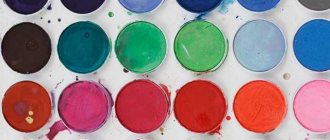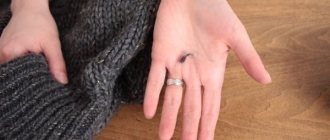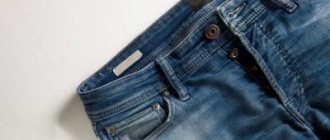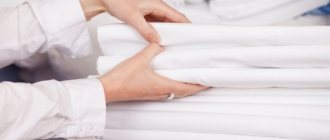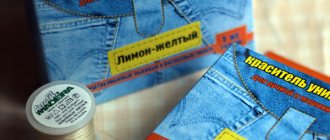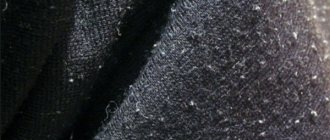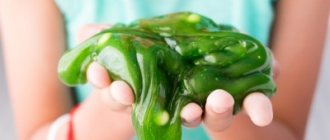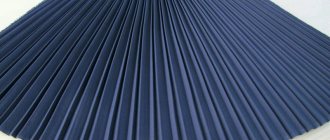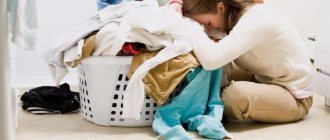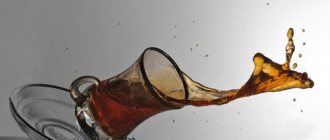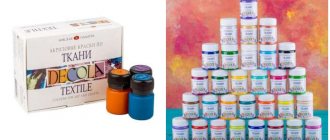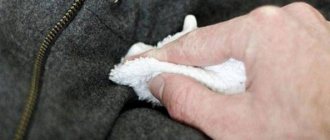Mold contains fungal spores and pathogenic bacteria, which can not only destroy fabrics and clothing, but also penetrate the human respiratory and skin tract, causing a number of unpleasant diseases. Finding it in time on clothes and bedding means protecting yourself and your family members.
The occurrence of fungus is caused by high humidity in cabinets and chests of drawers, in which under no circumstances should you put under-dried items. Even if the item seems to be dry, carefully check the waistbands, collars and cuffs of washed clothes - they need more time to dry.
Causes of mold on clothes
First, let's look at where and under what conditions we store our clothes. Usually it lies in closets and chests of drawers close to each other. As soon as one item, poorly dried after washing, lies in a closed space, a humid microclimate appears there. Mold does not grow in a dry place and where there is good ventilation. Therefore, high humidity is the most comfortable environment for the development of mold mycelium. And in order not to infect other things, you need to follow a few simple rules:
- Take your time to quickly put the washed clothes away in the closets. It may happen that some area of the clothing is not completely dry, for example, the collar of a shirt or a cuff. Over time, in a dark place, this will cause black mold to grow on clothes and in the closet itself.
- An important rule for cleaning rooms is to store dirty things separately from clean ones. After all, you can bring bacteria from the street, thus contaminating clean clothes.
- Periodically leave cabinet doors and drawers open for ventilation.
- In summer, on a dry and hot day, take it out to the balcony and leave winter and warm clothes for a day.
- Be sure to monitor the humidity in the apartment. Mold, also known as fungus, multiplies in conditions of high air humidity.
To prevent mold from growing in your clothes, periodically leave cabinet doors and drawers open for ventilation.
If you do not immediately notice mold on your clothes, and it has managed to grow over a large area of the fabric, this means that the fungus has already penetrated deeply into the fibers. Sometimes there are irreversible processes, and nothing can remove the mold. The fabrics begin to rot. The item cannot be preserved even after treatment with strong chemicals.
What to do to prevent the fungus from appearing again
Certain preventive rules should be followed:
- for the necessary air circulation, the cabinet should be moved 2-5 cm away from the wall;
- using hygrometers to monitor the level of humidity in the room or closet;
- after washing, dry the items in the open air, use an iron or steam generator, wait for them to cool for 10-15 minutes;
- After general cleaning, ventilate the wardrobe several times;
- hoods must not be broken;
- disinfection when washing is carried out with powder and soda, using a double rinse mode;
- always dry things on the balcony, put them dry in the closet;
- do not store clean clothes with dirty ones together;
- To protect against fungus, use moisture-absorbing bags;
- Do not store wet items in the laundry basket;
- Dry wet shoes thoroughly after seasonal use and put newspaper inside.
To remove mold, you need to test the product on an inconspicuous area. When dry cleaning, use vodka and soda. To clean delicate fabrics, use turpentine and ammonia. Dry clothes outdoors in direct sunlight.
The article has been verified by the editors
What to do if mold appears on things
You took out a towel from the closet that you hadn’t used for a long time and saw traces of mold on it. This is the first signal that a fungus has already settled in this place and, most likely, this is not the only thing affected by spores. Then let's start the fight:
- We take out all the things from the closet and carefully inspect them.
- We sort and put clean and slightly worn items into different piles.
- We re-wash all the clothes, both clean and already worn, because mold may appear later, although it is not yet visible.
- We treat the cabinet itself with alcohol and dry it for as long as possible. Then we ventilate it regularly.
- Next, we place one moisture-absorbing tablet on each cabinet shelf.
Sometimes mold appears on clothes that we put in the washing machine for later washing and we think: “I’ll accumulate more things and wash them all at once.” But the car is a source of high humidity; there is a small air flow inside it. This means that an ideal environment for mold growth appears - warm and humid.
I advise you not to accumulate a lot of laundry and wash it more often. The washing machine itself should be periodically treated from the inside with antibacterial agents and dried after each wash, especially the rubber seals on the door.
Dirty things need to be washed on time without accumulating
Probably, many housewives think that all they have to do is wash fabrics with detergents, and the mold will disappear by itself. However, experience shows that things with a severe stage of infection can only be saved with professional detergents using chlorine-containing preparations and bleach.
General recommendations
Before you wash mold from clothes, it is important to find out the cause of its occurrence in order to avoid spreading the problem to other items of clothing.
Typically, mold occurs due to improper drying of things or their long-term storage in a room with high humidity. Then the fungus appears on a small area of tissue and gradually grows, infecting other things.
When cleaning mold from clothes, it is recommended to follow the general algorithm:
- Dry cleaning of contaminated material from mold with a brush or the hard side of a sponge, aimed at maximum removal of growths.
- Processing and/or soaking fabric using special solvents or folk recipes.
- Wash the item in the usual way with the addition of powder and conditioner.
- Processing the washing machine to disinfect it.
It is important to pay attention to the last stage in order to avoid fungal contamination of clean items during further washing.
Valentin Vasilievich
Plumber
When treating affected items with special solutions, you should first study their composition and care recommendations prescribed by the manufacturer on the label. It is also recommended to test the selected product on a small area of the fabric before cleaning to avoid damage and discoloration.
How to remove mold from clothes
If mold appears on your favorite item, do not rush to throw it away. You can get rid of fungus using both professional means and folk methods.
Professional products
One way to save your favorite blouse is to take it to the dry cleaner. Mold dies at temperatures above 100 degrees or from the action of strong chemicals. Dry cleaning uses professional bleaches and stain removers.
But you can try to get rid of mold stains at home with the help of Whiteness. It contains chlorine, which serves as both a strong bleach and a disinfectant at the same time. The product works great with white cotton and linen fabrics. Bed linen, underwear, and kitchen towels are soaked in a bleach solution for several hours. To avoid inhaling chlorine vapors, cover the container with a lid while soaking. Some things, especially those seriously affected by fungus, can be boiled with a small amount of bleach. At this time, it is advisable to open the windows for air flow and ventilation.
Whiteness is good at removing mold from white things.
Light-colored cotton fabrics withstand boiling especially well. Colored items may lose color. Mold stains begin to disappear within 10 minutes from the start of boiling. It is not recommended to boil synthetic and woolen fabrics, as they do not tolerate high temperatures well. These fabrics are best treated with stain removers such as Vanish.
It is better to remove mold from synthetic and woolen fabrics using Vanish
Video: removing mold using Dosia gel
Folk remedies
In addition to professional means of combating mold, experienced housewives use many folk remedies in their arsenal, such as soda, vinegar, lemon juice and others.
Lemon juice
If white fabric can be saved by boiling, then colored fabric with unstable dyes is best treated with lemon juice. Mold is afraid of an acidic environment and will not multiply in it.
You can remove mold with lemon juice as follows:
- Apply a few drops of lemon juice to mold stains and leave for half an hour.
- Then sprinkle table salt on top and let dry.
- After this, be sure to wash the clothes in the washing machine with powder or gel.
Lemon juice can remove mold from colored items
Turpentine
Some fabrics can be treated well with turpentine:
- First, pour 1 tablespoon of turpentine over the stain.
- When the product disperses on the fabric, sprinkle cosmetic clay on top. It absorbs turpentine along with the softened fungus.
- Then cover the surface to be treated with clean paper, iron it and put the item in the wash.
Turpentine works great against mold on clothes
Hydrogen peroxide
Hydrogen peroxide can be used to remove mold on fabric. Before use, it is advisable to test the effect on an inconspicuous area of the fabric. If the fabric has not changed color, you can safely apply peroxide to the fungus for half an hour. After the time has passed, wash the clothes.
Hydrogen peroxide can be used to remove mold from fabric.
Ammonia
For colored clothes, you can use ammonia:
- The solution should be applied to the stains and wait 10–15 minutes. This time is enough for the fungal spores to die.
- The clothes should then be washed in the washing machine.
Before using ammonia, you should check how the solution acts on dyed fabric.
Ammonia can be used to remove mildew from colored fabrics
Laundry soap
To remove dirt, you can use laundry soap. The soap contains alkali, which any fungus is so afraid of. When exposed to an alkaline environment, spores cannot reproduce and quickly die.
To remove mold using laundry soap, follow these steps:
- Rub a bar of soap thickly over the mold-damaged area.
- Dip the item into hot water.
- Leave for 2 hours and put in the wash.
Laundry soap is the most affordable folk remedy for removing mold
conclusions
- Mold and mildew are dangerous enemies of humans, causing damage to clothing and affecting the health of household members.
- Most kitchen and pharmacy products found in any home can be used to neutralize mold-affected areas of clothing and linen. These are lemon juice, boric acid, vinegar, laundry soap, rock salt, alcohol, aspirin, etc.
- Removing an unpleasant odor after anti-mold treatment is no more difficult than removing wax from fabric; vinegar and gel conditioner added to machine wash will help.
- Items treated against mold should be dried for at least 12 hours outdoors in the sun.
- Ironed items should not be immediately put back in their places, since they still retain a large amount of condensed moisture. Let them “breathe.”
- Strong household chemicals and chemicals are not suitable for white and delicate fabrics.
- Before removing stains from colored fabrics using chemical methods, you should test their effect on a small piece of the item. If the fabric has not changed color within half an hour, then this product can be used.
- Moisture-absorbing tablets and sachets are a great help against mold in cabinets. It is enough to put one piece on each shelf to forget about humidity for several months or even six months.
- Periodically, any room requires ventilation for at least 10-25 minutes, even if there is dampness, cold and bad weather outside.
How to remove mold stains from different types of fabrics
Natural fabrics are difficult to treat to remove mold. They have a loose weave and weak fibers. Fungal spores penetrate deep inside and multiply quickly.
Removing mold from wool and silk
Chemical processing is best suited for wool and silk fabrics. If you can’t take your items to the dry cleaner, you can try removing the mold stain with turpentine or ammonia:
- We wet the napkin with the liquid and carefully treat the contaminated area.
- After this, sprinkle a small amount of cosmetic clay on top.
- Iron with a heated iron over the clay through clean paper.
- When the stain is dry, gently wash it in warm water and soap.
Cleaning linen fabrics
Linen and cotton items can be easily cleaned of mold with a simple salt solution:
- For better effect, you can add a few drops of ammonia to this solution.
- The prepared mixture should be applied to the affected area and wait a few minutes.
- Afterwards, the item must be washed thoroughly using powder and rinsed several times.
Saline solution is good at killing mold spores
Getting rid of mold from synthetic fabrics
Synthetic fabrics are also susceptible to the destructive effects of fungus. In this case, experienced housewives use ammonia:
- Dilute a few drops of ammonia in a small amount of water.
- Wet a cotton pad with the resulting solution and treat mold stains.
- Then we wash the product by hand or in the washing machine using gel or powder.
Removing mold from leather products
Mold spores on leather products mainly come from the street, and less often they spread from other household items. Leather is cleaned with the same products as other fabrics. Mechanical force can and should be applied to the skin, since it is a rather dense material.
The cleaning process goes like this:
- First, dry the product well and clean it of dirt.
- Prepare a soap solution and use a medium-hard brush to begin treating the mold stains. The same solution can be prepared with ammonia.
- At the end, simply wash off the residue with warm water and dry thoroughly again.
Ways to get rid of mold fungus
As you can see, there are many products that clean fabric from mold damage. However, this is not the entire list that can be tested in practice. As mentioned above, the method should be selected depending on your body (the presence or absence of a reaction to chemicals), as well as on the type of tissue.
Undoubtedly, more aggressive chemical compounds will be less easy to remove from fabric, and they should not be used if mold spores appear on a baby’s clothing. It is best to use folk remedies such as vinegar, ammonia, chalk, peroxide, citric acid, laundry soap and even yogurt.
Domestos
If you do not suffer from the above problems and are able to easily tolerate vapors of chlorine-containing substances, then you can use the help of Domestos. Be sure to follow the dosage, because excess product can have a detrimental effect on the structure of even the densest linen or cotton fabric.
Basic procedure:
- Dilute the cleaning solution in a saucepan in a ratio of 15 ml to 2 cups of water.
- Bring the diluted solution to a boil and immerse the contaminated items.
- We wait and watch for the mold to come off the fabric and remove the item.
- Next, you need to rinse thoroughly and wash on a standard cycle or, in the case of cotton, on a high-temperature program (Cotton 90).
Preventing mold from growing on clothes
Mold spores multiply quite quickly. At an advanced stage, they already give off a characteristic musty smell that thoroughly permeates both clothing and household items. Therefore, to prevent fungus and odors on things, you should follow certain rules for storing clothes:
- It is not recommended to place the wardrobe close to the wall. The optimal distance from the back of the cabinet to the wall is 6–8 centimeters. This is enough for normal air circulation.
- From time to time you need to ventilate the cabinets by opening doors and drawers for several hours.
- It is advisable to place one moisture-absorbing bag on each cabinet shelf.
- It would be good to periodically inspect things and inspect them for the appearance of mold spores.
- Do not rush to put things back in their places without making sure that the clothes are completely dry. It is better to keep them in the air for an extra hour. Even after ironing with a steam iron, the item has high humidity.
- It is necessary to monitor the humidity level in the apartment.
Prevention
Now you know how to remove mold stains from your favorite things. To prevent the reappearance of an unexpected guest, you should follow several rules, such as:
- Try to ventilate the room in which things are located.
- When we put clothes in the closet, be sure to check for the presence of moisture.
- Use special moisture-absorbing bags in your wardrobe.
- Wipe off water from your washing machine after use.
- Do not put dirty items in the washing machine drum for storage until the next wash.
- Wash the bowl at high temperature using bleach.
From white
Removing mold from white products is a difficult and complex process. It may require the use of not one, but several products that will gently clean the item from stains and leave no traces.
How to do it:
- It is necessary to pour hot water into a basin and add 1-2 tablespoons of washing powder.
- Rub mildewed areas with laundry soap.
- Immerse the products in a bowl of water for half an hour.
- After the specified time, you need to wash the item in a machine with the addition of a hydrogen peroxide solution. Add half a liter of water and a tablespoon of peroxide to the soap container.
Universal folk methods
The problem of mold did not appear recently, so there are traditional methods of combating the fungus. They may not remove stains in all cases, but they do not damage clothing.
A gruel made from ordinary onions has proven itself well in the fight against fungus, which is applied to the stain and washed off from clothes after twenty minutes. To get rid of the onion smell, the item should be dried in the sun.
Another method of saving clothes is to use yogurt. The item is soaked in it for half a day and then washed using the usual method.
Lemon juice is effective against mold by moistening a cloth and then sprinkling it with salt. The treated item is completely dried and washed using regular powder. It is possible to use acetic acid instead of lemon juice, but it is more aggressive and can damage the fabric.
You can even use tomato juice to remove fresh stains. They rub it on the damaged areas and after a while wash the laundry with plenty of water, then the item is washed using the usual method.
Cleaning the stroller
If mold appears on clothes, we have discussed how to get rid of it, now you can treat other surfaces, such as a baby stroller. Children's vehicles are most susceptible to mold growth. Naturally, in order to protect your child, you will have to take a number of measures that will remove this scourge.
You need to make a mushy paste using baking soda and plain water. We apply this paste to the moldy areas and remove the spores with a brush. You can also use citric acid or vinegar, and for a powerful effect we remove mold by treating the stroller fabric with turpentine.
- Samsung washing machine error h1
- SMA Samsung error codes
